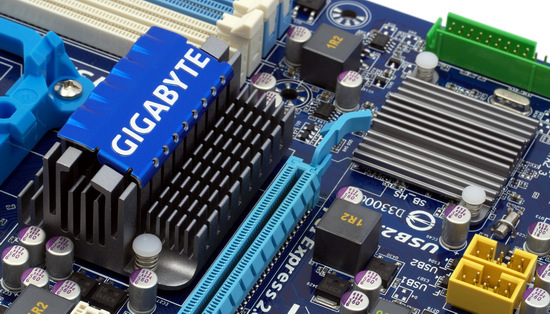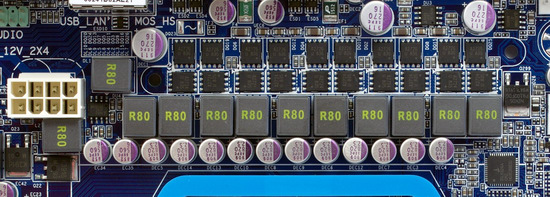We already reviewed Gigabyte MA770-UD3 with a similar layout. But it supported DDR2 memory. DDR3 memory has become much more popular of late. For one, due to the drop of prices for this memory type. For two, in connection with the rollout of quad-core Athlon II 6xx CPUs. These processors offer a very good price/performance ratio. But they don't have L3 Cache, so they are quite responsive to high-speed DDR3.
This model offers an interesting combination of an inexpensive discrete chipset and an imposing power supply system. And the board itself demonstrates practically a complete set of Ultra Durable features.
Design
This motherboard has a classic design. Although manufacturers are trying hard to distinguish their products, and even in case of chipsets that officially don't support multi-GPU configurations they install several graphics slots and add CrossFire support (for example, ASRock M3A770DE). On the other hand, in case of a single graphics port we cannot complain about a large graphics card in the second slot blocking access to SATA and IDE ports. Right? But in this case the IDE port is oriented vertically, installed right opposite to the graphics slot. However, it's still easy to plug the standard cable, if you remove the graphics card prior to this procedure.
The board has two BIOS chips installed: a primary chip and a backup one that safeguards users against flashing failures. The 12V power connector is located in an inconvenient place, its cable may go right over the CPU cooler in some cases. On the other hand, peripheral connectors are equipped with borders and labels, and there is even a FireWire 'plug'. By the way, this motherboard won't disappoint users of old printers and modems, as far as rare ports are concerned -- it has both LPT and COM (in the form of connectors for brackets with corresponding ports). On the positive side we can mention eight USB ports on the rear panel, on the negative -- no eSATA.
What concerns a cooling system for such a low-power chipset as AMD 770, we can take only theoretical objections, because from the practical point of view manufacturers have full power to save on heatsink size.
However, Gigabyte is not much of a saver: a heatsink on the Northbridge is rather high. From the ultimatistic point of view, it would have been better to find a different place for the nameplate, which does not contribute to free convection. And finally, if you find out that the chip gets hotter than expected, judging by the heatsink temperature, it will make sense to spend ten minutes on replacing the thermal grease. The heatsink is fixed with plastic knobs and may dislocate in transit or when you install the motherboard. The stock thermal grease is quite fragile, and dislocation may break thermal contact.
The voltage regulator of the processor uses a 10-phase design with two Low RDS (on) MOSFETs per channel and ferrite chokes. The power circuit also contains 12 x 820 uF and 3 x 470 uF solid capacitors from leading Japanese manufacturers. The board features twice as thick copper layers for power and ground. It supports processors with TDP up to 140 W.
What concerns the bundle, we can mention only SATA cables with metal latches and L-shaped connectors at one end, which makes the contact much more reliable. There is also a brief installation guide.
The software bundle includes such useful programs as EasyTune for system monitoring, fan speed control, etc; Face-Wizard for BIOS splash screen editing; Q-Share for convenient file sharing in a local area network, and @BIOS to download the latest BIOS version at the Gigabyte server and flash it. Third-party utilities include Norton Internet Security, Kaspersky AntiVirus, COREL MediaOne, and Roxio Buzz.
Write a comment below. No registration needed!



